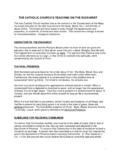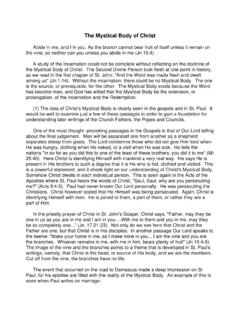Transcription of Everything You Wanted to Know about Lent - Father Peffley
1 Everything You Wanted to know about lent What is lent ? Historically, lent is the 40-day period before Easter, which the Church uses to prepare for the celebration of our Lord Jesus Christ's Resurrection on Easter sunday . When does lent begin? lent begins on Ash Wednesday, which is the day on which they faithful have their foreheads signed with ashes in the form of a Cross. It ends at noon on Holy Saturday. The 40 days excludes the five Sundays of lent . Why do Catholics have their foreheads marked with a cross on Ash Wednesday? Because in the Bible a mark on the forehead is a symbol of a person's ownership. By having their foreheads marked with the sign of a cross, this symbolizes that the person belongs to Jesus Christ, who died on a Cross.
2 This is in imitation of the spiritual mark or seal that is put on a Christian in baptism, when he is delivered from slavery to sin and the devil, and made a servant of righteousness and Christ (Rom. 6:3-18). It is also in imitation of the way the righteous are described in the book of Revelation: "Do not harm the earth or the sea or the trees, till we have sealed the servants of our God upon their foreheads." (Rev 7:3). Why is the signing done with ashes? Because ashes are a biblical symbol of mourning and penance. In Bible times the custom was to fast, wear sackcloth, sit in dust and ashes, and put dust and ashes on one's head. While we no longer normally wear sackcloth or sit in dust and ashes, the customs of fasting and putting ashes on one's forehead as a sign of mourning and penance have survived to this day.
3 These are two of the key distinctions of lent . In fact, Ash Wednesday is a day not only for putting ashes on one's head, but also a day of fasting. Is there another significance to the ashes? Yes. They also symbolize death and so remind us of our mortality. Thus when the priest uses his thumb to sign one of the faithful with the ashes, he says, "Remember, that thou art dust and unto dust thou shalt return," which is modeled after God's address to Adam (Gen 3:19; Job 34:15; Ps 90:3; Ps 104:29, Ecc 3:20). This also echoes the words at a burial, "Ashes to ashes; dust to dust," which is based on God's words to Adam and Abraham's confession, "I am nothing but dust and ashes" (Gen 18:27).
4 It is thus a reminder of our mortality and our need to repent before this life is over and we face our Creator. Where do the ashes used on Ash Wednesday come from? They are made by burning palm fronds which have been saved from the previous year's Palm sunday , they are then blessed by a priest -- blessed ashes having been used in God's rituals since the time of Moses (Num 19:9- 10, 17). Why are ashes from the previous year's Palm sunday used? Because Palm sunday was when the people rejoiced at Jesus' triumphal entrance to Jerusalem. They celebrated his arrival by waving palm fronds, little realizing that he was coming to die for their sins. By using palms from Palm sunday , it is a reminder that we must not only rejoice of Jesus' coming but also regret the fact that our sins made it necessary for him to die for us in order to save us from hell Why are Sundays excluded from the reckoning of the forty days?
5 Because sunday is the day on which Christ rose, making it an inappropriate day to fast and mourn our sins. On sunday we must celebrate Christ's Resurrection for our salvation. It is Friday on which we commemorate his death for our sins. The Sundays of the year are days of celebration and the Fridays of the year are days of penance. Why is lent forty days long? Because 40 days is a traditional number of discipline, devotion, and preparation in the Bible. Moses stayed on the Mountain of God 40 days (Ex 24:18, 34:28), Elijah traveled 40 days before he reached the cave where he had his vision (1 Kings 19:8), Nineveh was given 40 days to repent (Jon 3:4), and most importantly, prior to undertaking his ministry, Jesus spent 40 days in the wilderness praying and fasting (Matt 4:2).
6 Since lent if a period of prayer and fasting, it is fitting for Christians to imitate their Lord with a 40-day period. Christ used a 40-day period of prayer and fasting to prepare for his ministry, which culminated in his death and resurrection, and thus it is fitting for Christians to imitate him with a 40-day period of prayer and fasting to prepare for the celebration of his ministry's climax, Good Friday (His crucifixion) and Easter sunday (His Resurrection). Thus the Catechism of the Catholic Church states: "'For we have not a high priest who is unable to sympathize with our weaknesses, but one who in every respect has been tested as we are, yet without sinning' [Heb 4:15].
7 By the solemn forty days of lent the Church unites herself each year to the mystery of Jesus in the desert." (CCC 540). Why are the forty days called lent ? They are called lent because that is the Old English word for spring. Not just because it is the season of the year during which it falls, but because lent is the Church's Springtime during which we start fresh. This is something unique to English. In almost all other languages, lent 's name is a derivative of the Latin term, Quadragesima, or "the forty days.". What is a day of fast and abstinence? Under current canon law in the Western Rite of the Church, a day of fast is one on which Catholics who are eighteen to sixty years old are required to keep a limited fast.
8 In this country, one may eat a single, normal meal and have two snacks, so long as these snacks do not add up to a second meal. Children are not required to fast, but their parents must ensure they are properly educated in the spiritual practice of fasting. Those with medical conditions requiring a greater or more regular food intake can easily be dispensed from the requirement of fasting by their pastor. A day of abstinence is a day on which Catholics fourteen years or older are required to abstain from eating meat (under the current discipline in America, fish, eggs, milk products, and condiments or foods made using animal fat are permitted in the Western Rite of the Church, though not in the Eastern Rites.)
9 Again, persons with special dietary needs can easily be dispensed by their pastor. Is there a biblical basis for abstaining from meat as a sign of repentance? Yes. The book of Daniel states: "In the third year of Cyrus king of Persia .. 'I, Daniel, mourned for three weeks. I ate no choice food; no meat or wine touched my lips; and I used no lotions at all until the three weeks were over.'" (Daniel 10:1-3) By giving up good things and denying them to ourselves we encourage an attitude of humility, free ourselves from dependence on them, cultivate the spiritual discipline of being willing to make personal sacrifices, and remind ourselves of the importance of spiritual goods over earthly goods.
10 Since the Catholic Church only requires abstinence from meat on a temporary basis, it clearly does not regard meat is immoral. Instead, it regards it as the giving up of a good thing (which in less economically developed regions -- including the whole world until very recently -- was expensive and thus eaten at festive occasions, making it a sign of rejoicing). to attain a spiritual goal. On what basis does the Church have the authority to establish days of fast and abstinence? On the authority of Jesus Christ who told the leaders of His Church, "Whatever you bind on earth will be bound in heaven, and whatever you loose on earth will be loosed in heaven" (Matthew 16:19, 18:18).







